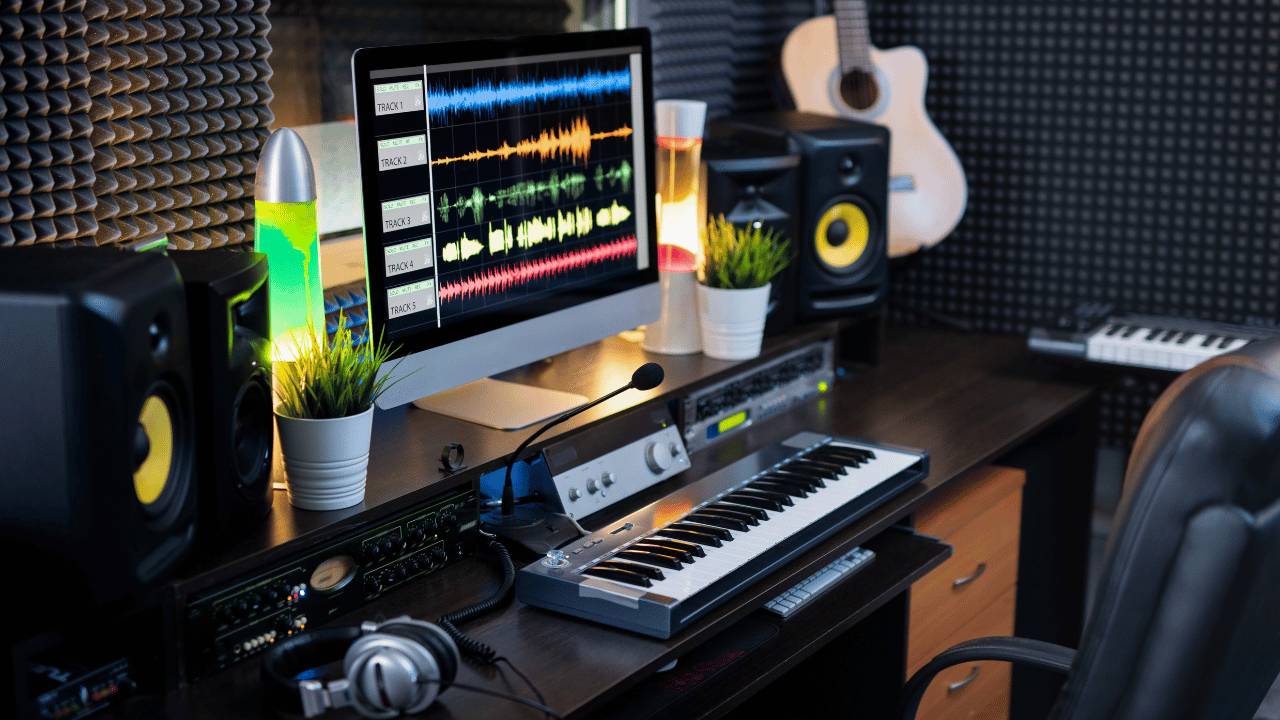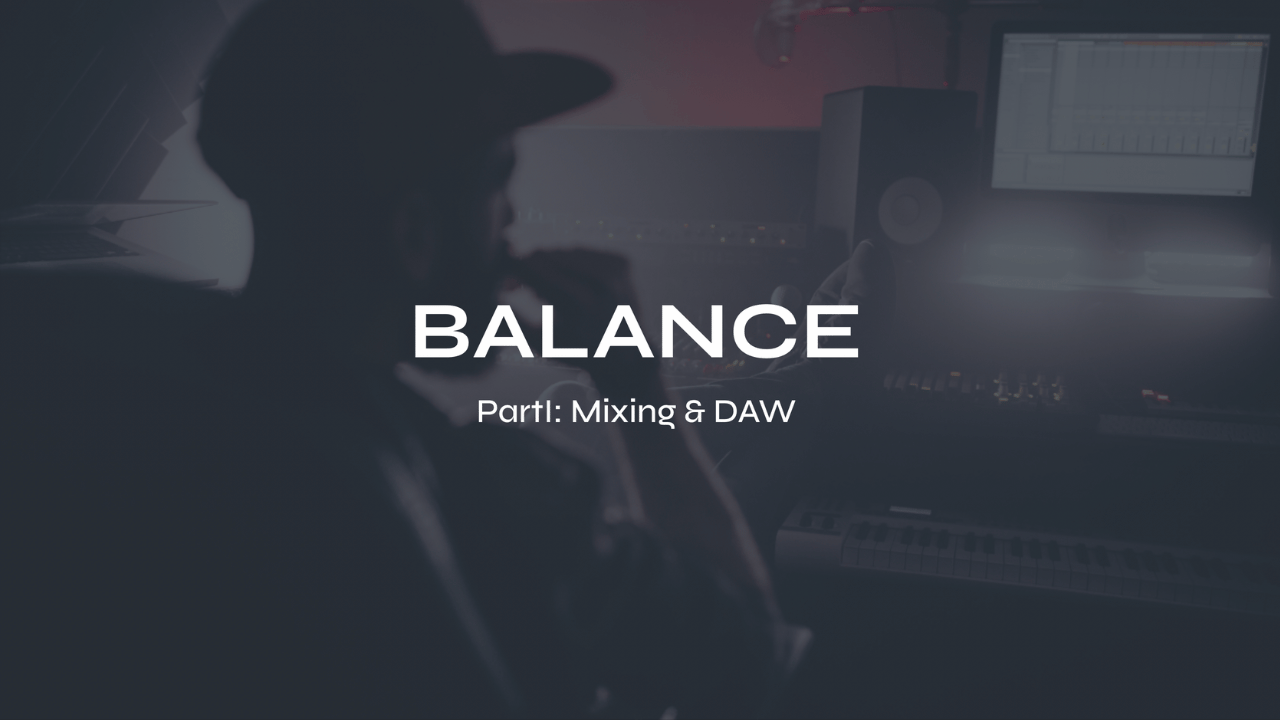5 Essential Elements of Music Production

Let’s take a look at five essential elements of music production: mixing, mastering, sound design, arranging, and workflow optimization. Each of these elements plays a critical role in creating professional-quality music, and understanding how they work together is key to achieving success as a music producer.

Download my FREE Guide The 4 Main Elements in Any Mix
Mixing
Mixing is the process of combining individual tracks and elements of a song to create a final mix. The goal of mixing is to achieve balance, clarity, and depth of sound. A well-mixed song should have a clear and defined structure, with each element of the mix occupying its own space in the stereo field. To achieve this, music producers use a variety of tools, including EQ, compression, delay, reverb, and panning.
Mixing is a crucial part of the music production process and requires a lot of technical skill and creativity. The mixing stage can make or break a song, as a poorly mixed track can sound muddy and unbalanced, while a well-mixed track can bring out the best in each individual element, resulting in a cohesive and engaging sound.
One of the primary goals of mixing is to achieve balance between the different elements of a song. This involves adjusting the volume levels of each track so that they all work together harmoniously. Music producers also use EQ to adjust the frequency balance of each element, making sure that each sound has its own space in the mix and doesn't clash with other elements.
Compression is another essential tool used in mixing, which helps to control the dynamic range of individual tracks and bring out the nuances of each sound. Reverb and other spatial effects can also be used to create a sense of depth and space in the mix, making it sound more immersive and engaging.
Panning is another powerful tool that music producers use to create a sense of space and separation between different elements. By placing different sounds in different parts of the stereo field, producers can create a more three-dimensional sound that feels more alive and dynamic.
Overall, mixing is a complex and nuanced process that requires a lot of skill and experience. A good mix should enhance the emotional impact of a song, drawing the listener in and keeping them engaged from start to finish. By using a combination of technical tools and creative techniques, music producers can create mixes that truly shine, bringing out the best in each individual element and creating a cohesive and compelling final product.

Download my Magic EQ and Compressor settings and more FREE guides here
Mastering
Mastering is the final step in the music production process, where a mix is polished and prepared for distribution. The goal of mastering is to enhance the overall sound of the mix, making it sound more polished, professional, and balanced. Mastering engineers use a variety of tools, including EQ, compression, limiting, and stereo widening to achieve the desired sound.
Mastering is a critical step in the music production process that can make a significant difference in how a final mix sounds. The mastering engineer's job is to ensure that the final mix sounds great on any playback system, whether it's on headphones, speakers, or in a club setting.
The mastering engineer uses a combination of technical tools and creative techniques to enhance the overall sound of the mix. One of the most common tools used in mastering is EQ, which can be used to adjust the frequency balance of the mix and make it sound more balanced and cohesive.
Compression and limiting are also important tools used in mastering, which can help to control the dynamic range of the mix and make it sound louder and more impactful. Stereo widening can also be used to create a more expansive sound, making the mix feel more immersive and engaging.
In addition to technical tools, the mastering engineer also relies on their ears and experience to make creative decisions about the mix. This may include making adjustments to the overall tonality of the mix, adding subtle effects or enhancements, or making small changes to the arrangement to improve the flow of the song.
Mastering is a crucial step in the music production process that can make a significant difference in the final product. By using a combination of technical tools and creative techniques, the mastering engineer can enhance the overall sound of the mix and create a polished, professional, and balanced final product that is ready for distribution.

Sound Design
Sound design is the process of creating or modifying sounds using digital or analog synthesis. Sound design is an important part of music production because it allows producers to create unique sounds that set their music apart from others. Producers use a variety of tools and techniques, including synthesizers, samplers, and digital audio workstations (DAWs), to create new and unique sounds.
Sound design is a creative process that requires a deep understanding of sound synthesis, music theory, and digital audio technology. Music producers use sound design to create a wide range of sounds, including musical instruments, sound effects, and ambient textures. A well-crafted sound design can make a song stand out from the rest, giving it a unique sonic identity that captures the listener's attention.
There are several types of sound synthesis that music producers use to create sounds. These include subtractive synthesis, additive synthesis, FM synthesis, and wavetable synthesis. Each type of synthesis has its own unique characteristics and can be used to create different types of sounds. For example, subtractive synthesis is commonly used to create bass sounds and leads, while FM synthesis is often used to create metallic and percussive sounds.
Music producers also use a variety of tools and techniques to shape and modify sounds. These include filters, envelopes, LFOs (low-frequency oscillators), and modulation effects like chorus and phaser. They also use samplers to manipulate and modify recorded sounds, such as drum samples or field recordings, to create new and unique sounds.
In addition to creating new sounds, music producers also use sound design to create soundscapes and textures that add depth and atmosphere to a song. For example, a producer may use a combination of synthesizers, effects, and field recordings to create an immersive, ambient soundscape that sets the mood for a song.
Sound design is an essential part of music production that allows producers to create unique sounds and textures that set their music apart from others. Producers use a variety of tools and techniques, including sound synthesis, sampling, and effects, to create new and innovative sounds that capture the listener's attention. A well-crafted sound design can elevate a song to the next level, creating a sonic landscape that draws the listener in and keeps them engaged.

Arranging
Arranging is the process of organizing the individual elements of a song into a cohesive whole. Good arranging is essential for creating a memorable and engaging song that captures the listener's attention. To arrange a song, music producers use a variety of techniques, including chord progressions, melody development, song structure, and dynamic changes.
Song arrangment is another key part of the music production process that can make or break a song. A well-arranged song should have a clear and engaging structure that keeps the listener engaged from start to finish. To achieve this, music producers use a variety of techniques to organize the individual elements of the song into a cohesive whole.
Chord progressions and melody development are two key elements of arranging that can make a significant difference in how a song sounds. By choosing the right chords and melody lines, producers can create a sense of emotion and tension that draws the listener in and keeps them engaged.
Song structure is another essential element of arranging, which involves organizing the different sections of the song into a cohesive whole. This may include using verse-chorus-bridge structures, creating a pre-chorus to build tension, or incorporating breakdowns or drop sections for added impact.
Dynamic changes are also crucial in arranging, which involves creating contrasts between different sections of the song. This can include changes in volume, instrumentation, or mood, which can add depth and complexity to the song and make it more engaging for the listener.
Overall, arranging is a complex and nuanced process that requires a lot of creativity and skill. A well-arranged song should be memorable, engaging, and emotionally resonant, drawing the listener in and keeping them engaged from start to finish. By using a combination of chord progressions, melody development, song structure, and dynamic changes, music producers can create songs that truly stand out and capture the listener's attention.

Download my Free Home Studio Setup Guide
Workflow Optimization
Workflow optimization is the process of streamlining the music production process to make it more efficient and effective. This involves identifying areas where time and resources can be saved, optimizing the use of technology and software, and developing efficient work habits. By optimizing their workflow, music producers can create more music in less time, and focus their efforts on the creative aspects of music production.
Workflow optimization can have a significant impact on the overall quality and efficiency of the music production process. By streamlining the workflow, producers can create more music in less time, while still maintaining a high level of quality and creativity.
One key aspect of workflow optimization is identifying areas where time and resources can be saved. This may involve using shortcuts and automation tools to speed up repetitive tasks, or developing templates and presets that can be used to quickly set up new projects or mix sessions.
Optimizing the use of technology and software is also essential in workflow optimization. This may involve investing in high-quality hardware and software tools, and staying up-to-date with the latest developments and updates in the music production industry. Producers may also need to customize their software settings and preferences to suit their specific needs and workflows.
Developing efficient work habits is another critical aspect of workflow optimization. This may involve setting up a dedicated workspace that is free from distractions, establishing a daily routine, and staying organized and focused throughout the production process. Producers may also benefit from working collaboratively with other music producers or artists, sharing ideas and feedback to help improve their workflow and productivity.
Workflow optimization is an ongoing process that requires constant evaluation and adjustment. By continually refining their processes and habits, music producers can create more music, more efficiently, while still maintaining a high level of quality and creativity.
In conclusion, mixing, mastering, sound design, arranging, and workflow optimization are all essential elements of music production. Each of these elements plays a critical role in creating professional-quality music, and understanding how they work together is key to achieving success as a music producer. By mastering these five elements, music producers can create music that is both unique and polished, and capture the attention of listeners around the world.
Futch - Music Production Coach and Ableton Certified Trainer
Check out my live online mixing course: BALANCE Part I:Mixing & DAW
BALANCE Part I: Mixing & DAW live online course
What you’ll get:
- 9 live online Zoom classes (each class is about 2.5 hours long)
scheduled to match the date & time availability of each cohort
- 9 on-demand video recordings of each module for review. You will always have access to these videos for reference.
- 9 module PDF reference guides.
- 9 assignments to practice what you’ve learned after each module
- Quizzes and self-assessments after each module to test your understanding of the concepts.
- A growing community of members to exchange feedback, ask questions and collaborate with.
- Educational discounts on select plugins and hardware from LEVELS partners for successful (80%) quiz results
100% Money-Back Guarantee - just contact support and let me know before class 5 starts. You will then lose access to everything.






